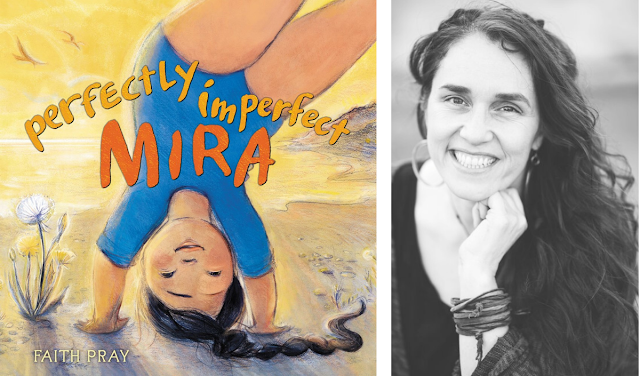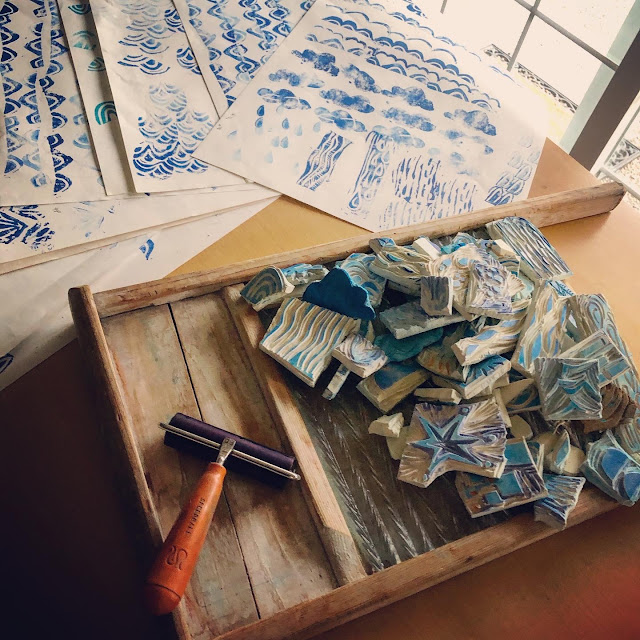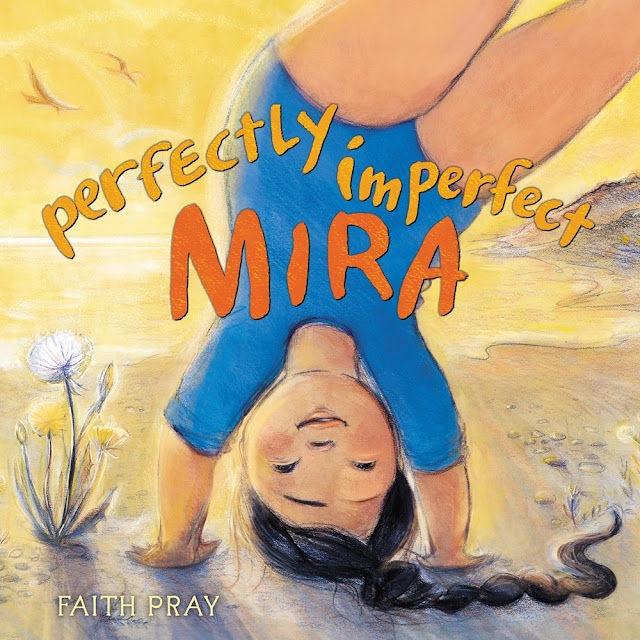Perfectly Imperfect Mira by Faith Pray is a perfectly imperfect story, and the process behind making the book was even more so! I got a chance to catch Faith and talk to her about this wonderfully uplifting and empowering book, and I'm thrilled to share our conversation with you today. Enjoy!!
About the book:
Mira wants to be perfect at everything she tries. Everyone around her is good at something, but Mira's not sure if she'll ever find a thing of her own.
One day, Mira decides to try . . . and because of that one simple act, everything changes. With a stumble, a wobble, and a humongous flop or two, will Mira learn to find the beauty in her imperfections?
One day, Mira decides to try . . . and because of that one simple act, everything changes. With a stumble, a wobble, and a humongous flop or two, will Mira learn to find the beauty in her imperfections?
Peek underneath the dust jacket:
Let's talk Faith Pray!
LTPB: Where did the idea for Perfectly Imperfect Mira come from? What inspired Mira’s personal journey?
FP: Our family is big into soccer, like really, really into soccer. When one of my twin daughters was 11, she decided she was done with all the soccer and wanted to try gymnastics. I worried about her starting a new thing as an older beginner. I figured most gymnasts her age have been tumbling for years, and everyone else in her class would surely be much younger? But she was determined to go for it, and we all watched as this quiet kid grew stronger, stood taller and more confident, and stuck with gymnastics - not in hopes that she’d become an Olympic superstar, but just because she loves it. I shared a sketch on social media after her first big gymnastics event, and my agent said - this is your next story! Which is how it started out being about my daughter who wanted to leave soccer and start gymnastics, and grew to became a story about perfectionism and Mira, who wants to be good at something, but everyone else is already better.
Mira’s journey of learning to enjoy the process is also a little bit of my own, too. Maybe finding echoes of our own stories within our work happens to a lot of writers! I had a stroke nine years ago and struggled with some epic writer’s block after that, so I took visual illustration classes through UC San Diego’s extension program to try to find a way back to writing, ended up falling in love with picture books and began to try to grow myself into a writer-illustrator. Somewhere in that process of being an older beginner a few seeds of Mira’s story must have been planted.
LTPB: Can you talk a little bit about the visual evolution of this book and Mira’s world? As you got to know the characters and Mira’s story developed, how did your illustrations evolve?
FP: Around the time I was developing what Mira would look like, I read a thread on Twitter by one of my library heroes Angie Manfredi about body representation in books. It made me feel deep in my bones that I want my work to show readers of all shapes and abilities that they can star in their own stories. And Angie’s words were very much in my mind as I worked out how Mira would look. When I first started drawing she was aged younger, but my editor and the design team at Little Brown pointed out that the age kids start to compare their abilities to others is older than what I’d show, so I drew Mira over and over and multiple ages until I found a spot that felt just right.
FP: Our family is big into soccer, like really, really into soccer. When one of my twin daughters was 11, she decided she was done with all the soccer and wanted to try gymnastics. I worried about her starting a new thing as an older beginner. I figured most gymnasts her age have been tumbling for years, and everyone else in her class would surely be much younger? But she was determined to go for it, and we all watched as this quiet kid grew stronger, stood taller and more confident, and stuck with gymnastics - not in hopes that she’d become an Olympic superstar, but just because she loves it. I shared a sketch on social media after her first big gymnastics event, and my agent said - this is your next story! Which is how it started out being about my daughter who wanted to leave soccer and start gymnastics, and grew to became a story about perfectionism and Mira, who wants to be good at something, but everyone else is already better.
Mira’s journey of learning to enjoy the process is also a little bit of my own, too. Maybe finding echoes of our own stories within our work happens to a lot of writers! I had a stroke nine years ago and struggled with some epic writer’s block after that, so I took visual illustration classes through UC San Diego’s extension program to try to find a way back to writing, ended up falling in love with picture books and began to try to grow myself into a writer-illustrator. Somewhere in that process of being an older beginner a few seeds of Mira’s story must have been planted.
FP: Around the time I was developing what Mira would look like, I read a thread on Twitter by one of my library heroes Angie Manfredi about body representation in books. It made me feel deep in my bones that I want my work to show readers of all shapes and abilities that they can star in their own stories. And Angie’s words were very much in my mind as I worked out how Mira would look. When I first started drawing she was aged younger, but my editor and the design team at Little Brown pointed out that the age kids start to compare their abilities to others is older than what I’d show, so I drew Mira over and over and multiple ages until I found a spot that felt just right.
In early drafts, I thought Mira would be a green, garden-y, growing book, maybe with seeds, a vine rope that traveled throughout the story, comparisons between Mira and many other characters throughout the book, but the more I looked for the heart of Mira’s story, the more it felt like Mira kind needed to be a solo story. And growing happens everywhere, not just gardens, so I weeded (pun!) that draft refocused on just Mira and her journey instead of tracking multiple characters in places of growth. I pulled in some of my favorite Pacific Northwest beach - ocean, rocks, driftwood, sprinkles of long grasses and dandelion, light and shadows and sky color changing the mood of everything as the day progresses. I love my editor Nikki’s suggestion to use color to delineate between Mira’s natural world, self-doubt world, and perfectly imperfect world.
For every draft, I made a dummy with rough thumbnail sketches to block out the flow and page turns, and then once those were approved, I created more refined rough sketches, and then once those were approved, I moved on to final pencil sketches, and then final art.
LTPB: What did you find most difficult in creating this book? What did you find most rewarding?
FP: Okay, so the most difficult part of creating the art for Mira has a bit of a story. I grew up in a family of artists - my dad and brothers are all clever and amazing children’s book authors and illustrators (Richard Jesse Watson, Jesse Joshua Watson, Benjamin J Watson), and when I was a kid, I used to go sit in my dad’s studio and watch him turn ideas into magnificence. Being in his studio was being in a realm of magical curiosities. He had this collection of ink bottles that I remember thinking looked like jewels. They still do, only dustier. He gave them to me. On some of the ink, the rubber stopper is permanently melded to the glass top and when you try to unscrew, it sort of dissolves into your hand. But mostly, the inks work great. I loved feeling like I was using old artifacts to make art, and decided to use them to glaze over my final sketches. I thought the inks would give this warmth to everything, but for some reason, maybe it was the colors I happened to pick or maybe these two specific inks looked different on my illustration board than they did on my early experiments, but after glazing, every board glared this weird 1980s sort of neon tint that took weeks to tone down. That was definitely my most Mira-esque journey of making this book.
I think my favorite part of making this book was doing the cover. I loved thumbnailing heaps of different cover designs and lettered titles and sending them to my team at Little Brown. Once they picked a favorite, I made color mock ups, then a rough sketch and final sketch, added paint and pencil details, and cleaned it all up in photoshop. And then, just for fun, I asked if we could make a case cover, too, and they said yes!
LTPB: What did you use to create the illustrations in this book? Is this your preferred medium? How does your process change from book to book?
FP: Pencils are my favorite! I love the soft, messy imperfection of pencil, which felt exactly right for Mira’s book. On top of the pencil line work, I added watercolor ink washes, color pencils and watercolor pencils, with clean up in photoshop.
My process absolutely changes from book to book. I feel like I’m learning how to do it all over again every time there is a new book to write or illustrate. The most recent book I’ve been trying to write involved sticky notes and cutting my text into strips like a dissembled puzzle.
I recently delivered the illustrations for Joanna Ho’s One Day (Harper Collins in winter ’23), and that art involves overlays of hand cut linoleum block prints, which was a thrilling experiment and I definitely want to play more with block printing.
LTPB: What are you working on now? Anything you can show us?
FP: I am currently working on my second author-illustrator book with Little Brown, as well as illustrations for Dianne White’s Finding Grateful (Chronicle, Spring ’24). I can share a tiny peek from a spread in the upcoming One Day (written by Joanna Ho, Harper Collins ’23).
LTPB: If you got the chance to write your own picture book autobiography, who (dead or alive!) would you want to illustrate it, and why?
FP: What a great question. I have sooo many favorite illustrators! I could tell you about all of them, but that would take us days, so I’ll just share a few favorites - Vali Mintzi - for her surprising Matisse-like colors and lines, Luisa Uribe’s joyful characters and colors, Joy Hwang Ruiz’s soft, glowy warmth, Julie Flett’s spacious, graceful design.
LTPB: What did you find most difficult in creating this book? What did you find most rewarding?
FP: Okay, so the most difficult part of creating the art for Mira has a bit of a story. I grew up in a family of artists - my dad and brothers are all clever and amazing children’s book authors and illustrators (Richard Jesse Watson, Jesse Joshua Watson, Benjamin J Watson), and when I was a kid, I used to go sit in my dad’s studio and watch him turn ideas into magnificence. Being in his studio was being in a realm of magical curiosities. He had this collection of ink bottles that I remember thinking looked like jewels. They still do, only dustier. He gave them to me. On some of the ink, the rubber stopper is permanently melded to the glass top and when you try to unscrew, it sort of dissolves into your hand. But mostly, the inks work great. I loved feeling like I was using old artifacts to make art, and decided to use them to glaze over my final sketches. I thought the inks would give this warmth to everything, but for some reason, maybe it was the colors I happened to pick or maybe these two specific inks looked different on my illustration board than they did on my early experiments, but after glazing, every board glared this weird 1980s sort of neon tint that took weeks to tone down. That was definitely my most Mira-esque journey of making this book.
LTPB: What did you use to create the illustrations in this book? Is this your preferred medium? How does your process change from book to book?
FP: Pencils are my favorite! I love the soft, messy imperfection of pencil, which felt exactly right for Mira’s book. On top of the pencil line work, I added watercolor ink washes, color pencils and watercolor pencils, with clean up in photoshop.
LTPB: What are you working on now? Anything you can show us?
FP: I am currently working on my second author-illustrator book with Little Brown, as well as illustrations for Dianne White’s Finding Grateful (Chronicle, Spring ’24). I can share a tiny peek from a spread in the upcoming One Day (written by Joanna Ho, Harper Collins ’23).
FP: What a great question. I have sooo many favorite illustrators! I could tell you about all of them, but that would take us days, so I’ll just share a few favorites - Vali Mintzi - for her surprising Matisse-like colors and lines, Luisa Uribe’s joyful characters and colors, Joy Hwang Ruiz’s soft, glowy warmth, Julie Flett’s spacious, graceful design.
Thank you so much to Faith for talking to me about this book! Perfectly Imperfect Mira publishes one week from today, April 12, from Little, Brown Books for Young Readers!
Special thanks to Faith and Little Brown for use of these images!

This post contains affiliate links. For more information, visit my policies & disclosures page




































Such an inspirational interview and so interesting to read the process FP engaged in to write and illustrate! Thank you for this method of sharing the evolution from idea to creation. EKHOPPER
ReplyDeleteMy pleasure, thanks for following along!
DeleteI'm completely unathletic, but I started playing hockey as an adult because I love the sport so much. I can really identify with Mira. It sounds like this book has a message for everyone.
ReplyDeleteAw, thank you for sharing Janet! And YES, a message for everyone!
DeleteWhat a beautiful book, and I love seeing all the development and change that the characters and story goes through. It underscores so well the lessons about embracing imperfection as the starting point of growth!
ReplyDeleteYes!! Such a beautiful message!
Delete